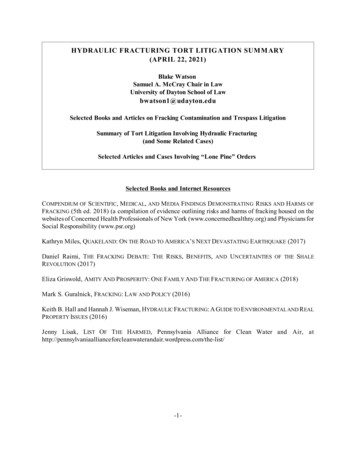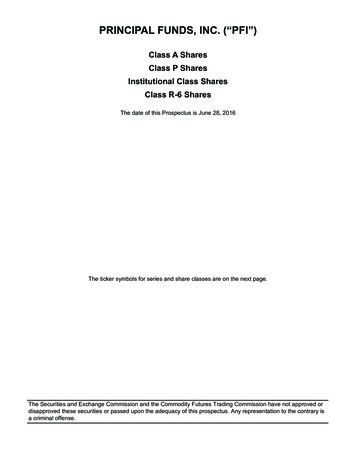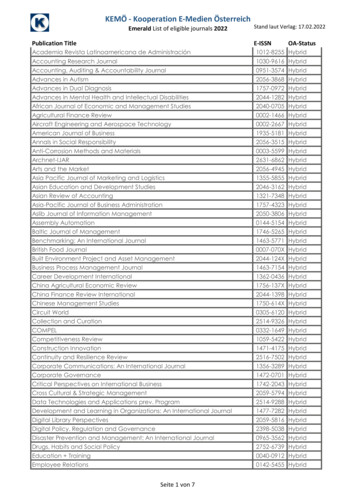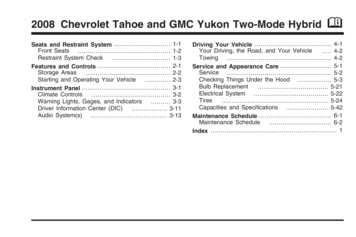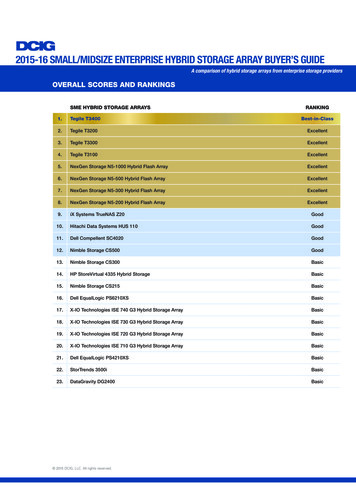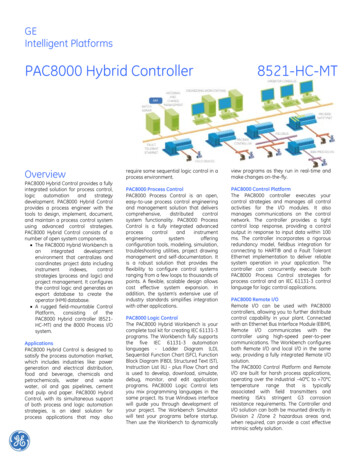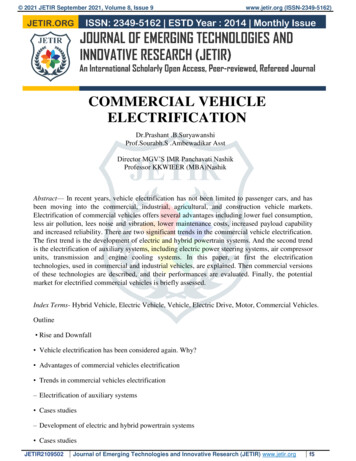
Transcription
Artículo arbitradoApplication of hybrid fracturing treatment in sandstone formations with highcontent of carbonate and mixed layers using acid and proppantAlejandro Javier Flores NeryHalliburtonEber Medina del AngelHalliburtonKatya Campos MonroyHalliburtonArtículo recibido, revisado y aprobado en 2020AbstractA formation in northern Mexico includes a lithological transition between sandstones and carbonate referred to as BrechaA. Because of the high content of carbonate and mixed layer, Brecha A has a low average porosity of approximately 10%;the permeability ranges from 0.1 to 5 mD. This paper provides details about the generation, application, and productionresults of a stimulation treatment design that works well for this type of formation. The design selected uses a fracturestimulation with 15% hydrochloric acid (HCl) systems, immediately followed by pumping a hydraulically proppedfracture treatment to generate an effective proppant pack in the fracture to further enhance productivity.During the initial stimulation attempts, only proppant was pumped, which caused premature screenouts during operationsthat resulted in poor conductivity of the proppant pack and low production. After considering the carbonate content ofthe formation and solubility with HCl, a hybrid operation was designed to avoid screenouts and to increase the proppantconcentration achieved with the fracturing operation.The challenges of this type of operation include combining the use of an acid system followed by the crosslinked gel topump sand into the formation with no fluid transport issues, and increasing the well productivity through the conductivitychannels created. The application of this type of operation helped to reduce surface pressure. After the acid contactedthe carbonate rock, the rock was dissolved in the acid. The dissolution was followed by a proppant slurry to maintain theopen fracture and to maximize conductivity.Previous proppant laden treatments using conventional techniques were not pumped to completion, and the potentialto economically produce the zone was questioned because of low productivity. After changing the design, a total of15 fracture treatments have been performed using this methodology; early screenout was reduced by 60%, and wellproductivity was increased by 80%.Keywords: Fracturing, hybrid, carbonate, mix layers, acid/proppant.398 Ingeniería PetroleraVOL. 60, No. 6, NOVIEMBRE-DICIEMBRE 2020
Alejandro Javier Flores Nery, Eber Medina del Ángel, Katya Campos MonroyAplicación de fracturamiento hidráulico híbrido en formaciones de arena conalto contenido de carbonato y capas mixtas utilizando ácido y apuntalanteResumenUna formación ubicada en el norte de México incluye una transición litológica entre areniscas y carbonato denominadaBrecha A. Debido al alto contenido de carbonato y a capa mixta, la Brecha A tiene una baja porosidad media deaproximadamente el 10 %; con rango de permeabilidad que oscila entre 0.1 y 5 mD. Este articulo proporciona detallessobre el desarrollo, aplicación y resultados de producción de un diseño de tratamiento de estimulación que funciona bienpara este tipo de formación. El diseño seleccionado corresponde a un fracturamiento hidráulico que incluye sistemas deácido clorhídrico (HCl) al 15%, seguido inmediatamente por el bombeo de un tratamiento con apuntalante, para generarun paquete efectivo apuntalado y así mejorar aún más la productividad.Durante los primeros intentos de estimulación, sólo se bombeaba apuntalante, lo que provocó arenamiento prematurodurante las operaciones, lo que dio lugar a una mala conductividad de la fractura apuntalada y una baja producción. Trasconsiderar el contenido de carbonatos de la formación y la solubilidad con HCl, se diseñó una operación híbrida paraevitar arenamiento y aumentar la concentración de apuntalante durante la operación de fracturamiento.Los retos de este tipo de operación incluyen la combinación del uso de un sistema ácido seguido del gel reticulado parabombear arena hacia la formación sin problemas de transporte de fluidos, y el aumento de la productividad del pozo através de los canales de conductividad creados. La aplicación de este tipo de operación ayudó a reducir la presión desuperficie, debido a la acción del ácido al entrar en contacto con la roca carbonatada. A la disolución de la roca, le siguióuna lechada de apuntalante para mantener la fractura abierta y maximizar la conductividad.Los tratamientos previos, empleando solo apuntalante y con el uso de técnicas convencionales no se bombeaban hasta laterminación, y se cuestionaba el potencial de producir económicamente la zona debido a la baja productividad. Despuésde cambiar el diseño, se realizó un total de 15 tratamientos de fracturamiento con esta metodología; el arenamientotemprano se redujo en un 60% y la productividad de los pozos aumentó en un 80%.Palabras clave: Fracturamiento hidráulico, híbrido, carbonato/arena, ácido.IntroductionThe Chicontepec basin is located in northern Mexico. Itpresents a stratigraphy formed by a discordance in thislithological transition, referred to Brecha A. Brecha A islocated in the Mendez formation in the upper Cretacicbetween the Turonian and Cenomanian. This lithologicalgroup consists of carbonate gaps and sloping clastic rocks(dolomitized or partially dolomitized). It includes rocksderived from the platform edge; consequently, it containsclasts or reef environment, mollusks, and rudists. Thepresence of clays as a matrix in these sediments supportsthe pelagic origin of their sediments. Although the averagethickness of this sequence is 200 m in the Poza Rica area,local thicknesses may be greater; in some areas, it is reportedVOL. 60, No. 6, NOVIEMBRE-DICIEMBRE 2020to vary from 300 to 1500 m. Its deposit environment is thatof a slope, representing the intermediate facies betweenreef deposits and the open sea. Given the presence ofbioclastic, brechoid, and microcrystalline carbonate rocks,it corresponds to potential hydrocarbon-producing andstorage rocks, (Nava and Alegría, 2001).This unit was formed by an intraformational breach withpackestone and grainstone fragments, foraminiferalmudstone and microcrystalline dolomites, and calcareoussand, with a greater percentage of shales denominated ascalcarenites (Nava and Alegría, 2001).Typically, hydraulic fracturing treatments involving the useof proppant were performed in this Brecha A formation.Ingeniería Petrolera 399
Application of hybrid fracturing treatment in sandstone formations with high content of carbonate and mixed layers using acid andproppant, p. p. 398-410However, the treatment schedules were difficult tocomplete because of the low capability of the formationto remain open with sufficient fracture widths to continuepumping increased proppant concentrations (greaterthan 2 or 3 ppg). The lack of conductivity in the formationand the reservoir fluid characteristics (medium to heavyoil with 12 to 15 API) led to poor productivity after thehydraulic fracture treatment. Techniques commonly usedin hydraulic fractures to increase proppant placementincluded increased pumping rates (to decrease fluid leakoffand maintain the fracture geometry longer), higher polymerloadings (to increase fracture widths and to reduce fluidlosses in the formation), and decreased proppant size (toenable pumping at higher proppant concentrations andto reach a higher conductivity). However, these changesachieved similar results of early screenout.Because of the characteristics of the deeper intervals inthe Brecha 1 and 2 formations (low permeability rangingfrom 0.1 to 5 mD, with limestone and dolomite content), anacid fracture treatment was considered as an alternative toincrease the productivity of the Brecha A formation wells.The initial acid fracture treatment trials showed productionresults less than those expected. The primary reason for thisfailure was that the solubility of the rock with hydrochloricacid was low, as compared to the required 85% solubilityfor acid fractures.Because of the geological and petrophysical characteristicsof the reservoir, a different design was used. The newdesign took into consideration that the permeability rangeand average porosity are low and that previous hydraulicfracturing treatments could not be completed becauseof premature screenout. Reviewing the results of localmineralogy, it was determined that an acid system usedas a preflush before the proppant fracturing treatmentcould help to dissolve the carbonate gaps and slopingclastic rocks (dolomitized or partially dolomitized) and toincrease the probability of successful proppant placementand completion of the fracturing treatment with thisincreased etched width. These determinations supportedthe application of hybrid fracturing treatments using acidand proppant for this formation.Field applicationA study sample of 14 wells determined that the Brechaformation has been treated primarily with hybrid fracturingtreatments, which represents 86% of the operations, and14% that were treated with proppant fracturing and aspearhead acid, Figure 1. The average length of the treatedinterval is 26 m; the total proppant pumped from theinitial stages of the learning curve ranged from 100,000 to150,000 lb of proppant to a later time volume of 200,000lb or greater proppant mass. The average proppantconcentration of the hybrid treatments was 4.6 lb/gal, andthe maximum concentration achieved in a fracture was 6lb/gal. The hybrid fractures were characterized for pumpingschedules with HCl volumes from 40 to 60 m3 of 15% HClwith or without gelling agents. Optimized volumes rangedfrom 25 to 20 m3 of acid system. The average pumping rateduring the jobs was 32 bpm, Figure 2, which required anaverage hydraulic horsepower of 3,900 HHP, considering5,000 psi as the surface treating pressure. Figure 3 throughFigure 5 show treatment charts with the implementation ofhybrid and propped treatments in wells A, B, and C.Figure 1. Treatment distribution types in the Brecha A formation.400 Ingeniería PetroleraVOL. 60, No. 6, NOVIEMBRE-DICIEMBRE 2020
Alejandro Javier Flores Nery, Eber Medina del Ángel, Katya Campos MonroyFigure 2. Average pumping rate during the hybrid fracturing treatments.Figure 3. Well A, chart of the hybrid fracture treatment performed.VOL. 60, No. 6, NOVIEMBRE-DICIEMBRE 2020Ingeniería Petrolera 401
Application of hybrid fracturing treatment in sandstone formations with high content of carbonate and mixed layers using acid andproppant, p. p. 398-410Figure 4. Well B treatment chart for a hybrid fracture treatment.Figure 5. Well C treatment chart of the hybrid proppant treatment.402 Ingeniería PetroleraVOL. 60, No. 6, NOVIEMBRE-DICIEMBRE 2020
Alejandro Javier Flores Nery, Eber Medina del Ángel, Katya Campos MonroyCase 1: Well AWell A was completed in the Brecha A formationthrough 5 in. casing, 17 lb/ft, N-80. A hybrid fracturingtreatment was performed to stimulate the interval at2,329 to 2,341 m; 12 m of the interval was perforatedwith a 3-3/8-in. gun. The permeability of this zone is 1.8md, the porosity was 13%; the reservoir pressure was5,000 psi, and the bottomhole temperature was 98 C.Table 1 lists the data generated and obtained after thework was completed.PropertyValueTotal fluid used in minifrac4,788 galAverage pumping rate (minifrac)40 bpmAverage surface treatment pressure3.500 psiInstantaneous shut-in pressure (ISIP)2.483 psiFracture gradient0.77 psi/ftTortuosity friction pressure198 psiPerforations friction pressure743 psiTotal fluid used during fracture treatment78.300 galAcid5,283 galSand concentration1-5 ppgTotal sand volume pumped1,600 sacksAverage pumping rate (fracture)40 bpmAverage surface treatment pressure (fracture)3,043 psiPropped length122 mPropped width0.43 inPropped height57 mAverage conductivity1,058.5 md-ftFCD4.82Table 1. Well A data.Figure 6 displays behavior of leak off during the Minifrac performed in Well A, normal leakoff was detected and the nearwellbore frictions were distributed with 198 psi to perforations and 743 psi to tortuosity.VOL. 60, No. 6, NOVIEMBRE-DICIEMBRE 2020Ingeniería Petrolera 403
Application of hybrid fracturing treatment in sandstone formations with high content of carbonate and mixed layers using acid andproppant, p. p. 398-410Figure 6. Fall off diagnostic analysis – G Function.Before this operation, the well produced a maximum oil rate of 200 bopd. After the operation, however, a maximumproduction rate was reached before a stable production rate is maintained. This result occurs over time as a result of the lowreservoir permeability. Figure 7 shows the production oil rate history of Well A.Figure 7. Production history of Well A.404 Ingeniería PetroleraVOL. 60, No. 6, NOVIEMBRE-DICIEMBRE 2020
Alejandro Javier Flores Nery, Eber Medina del Ángel, Katya Campos MonroyCase 2: Well BWell B was producing from the Brecha A-1 formationwhen the hybrid fracturing treatment was performed. Thiswell was completed through 5 in. casing, 17 lb/ft, N-80.The focus of the fracturing treatment was to stimulatethe interval at 2,205 to 2,235 m; 30 m of interval wasperforated with a 3-3/8-in. gun. The permeability of thiszone is 1.07 md, and the porosity was 15.5%. The reservoirpressure was 5,200 psi, and the bottomhole temperaturewas 105 C. Table 2 shows the data generated and obtainedafter this work was completed.PropertyValueTotal fluid used in minifrac1,890 galAverage pumping rate (minifrac)32 bpmAverage surface treatment pressure2.500 psiInstantaneous shut-in pressure (ISIP)2.670 psiFracture gradient0.80 psi/ftTotal fluid used during fracture treatment67,494 galAcid11,888 galSand concentration1-6 ppgTotal sand volume pumped1,250 sacksAverage pumping rate (fracture)33 bpmAverage surface treatment pressure (fracture)3,900 psiPropped length171.9 mPropped width0.168 in.Propped height26.55 mAverage conductivity2,065 md-ftFCD25Table 2. Well B data.Figure 8 displays behavior of leak off during the Minifrac performed in Well B, normal leakoff was detected and the nearwellbore frictions were distributed with 565 psi to perforations and 200 psi to tortuosity. This treatment started with a watercontrol pre-treatment to avoid production of unwanted fluids after the frac.VOL. 60, No. 6, NOVIEMBRE-DICIEMBRE 2020Ingeniería Petrolera 405
Application of hybrid fracturing treatment in sandstone formations with high content of carbonate and mixed layers using acid andproppant, p. p. 398-410Figure 8. Fall off diagnostic analysis – G Function.Figure 9 shows the oil production history of Well B. After the fracturing work was performed, an average of 50 bopd wasproduced in a 2-year period, as compared to 13 bopd produced before the fracture. The operation represents a 3.8-foldproduction increase.Figure 9. Production history of Well B.406 Ingeniería PetroleraVOL. 60, No. 6, NOVIEMBRE-DICIEMBRE 2020
Alejandro Javier Flores Nery, Eber Medina del Ángel, Katya Campos MonroyCase 3: Well CWell C was completed in the Brecha A formation through 5 in. casing, 17 lb/ft, N-80. A hybrid fracturing treatment wasperformed to stimulate the interval of 2,248 to 2,285 m, for a total formation exposure of 37 m, which was perforated with a2-1/8-in. gun. The permeability of this zone was 0.784 md, and the porosity was 13.4%. The reservoir pressure was 5400 psi,and the bottomhole temperature of 88 C. Table 3 shows the data generated and obtained after the treatment was completed.PropertyValueTotal fluid used in minifrac4,116 galAverage pumping rate (minifrac)23 bpmAverage surface treatment pressure5.200 psiInstantaneous shut-in pressure (ISIP)3,014 psiFracture gradient0.87 psi/ftTotal fluid used during fracture treatment82,950 galAcid5,283 galSand concentration1-5 ppgTotal sand volume pumped1,800 sacksAverage pumping rate (fracture)35 bpmAverage surface treatment pressure (fracture)5,660 psiAverage propped length127.9 mAverage propped width0.084 inAverage propped height55.16 mAverage conductivity1,150 md-ftFCD3.9Table 3. Well C data.Figure 10 shows the oil production history of Well C. After completing the fracturing work, a maximum rate of 47 bopd wasdocumented, with an average rate of 22 bopd afterward.VOL. 60, No. 6, NOVIEMBRE-DICIEMBRE 2020Ingeniería Petrolera 407
Application of hybrid fracturing treatment in sandstone formations with high content of carbonate and mixed layers using acid andproppant, p. p. 398-410Figure 10. Production history of Well C.The following table shows a summary of the information, design and production results of the studied wells.Table 4. Comparison of well results.408 Ingeniería PetroleraVOL. 60, No. 6, NOVIEMBRE-DICIEMBRE 2020
Alejandro Javier Flores Nery, Eber Medina del Ángel, Katya Campos MonroyConclusionsAfter performing the fracturing treatments, an optimalhybrid treatment for the Brecha A formation was tested.There were 14 hybrid fracture treatments performed inwells before the main fracture (or as a preflush followedby proppant stages) were performed in this formation. Thefollowing list summarizes the improvements made to thetreatment to complete the fracture treatment as designedand to improve the productivity of the wells. 80% of the treatments that were perforated with 21/8-in. guns were successful, as compared to 55% ofthe treatments when perforated with 3 3/8-in. guns. Intervals with porosity values of less than 10% hada better probability of treatment completion, ascompared with intervals with average porosity valuesof greater than 10%. The combination of hybrid treatment with the BrechaA and Brecha 1 formations open at the same timeresulted in early screenout. Hybrid treatments with an initial pump rate ofless than 30% (of the average) had a 50% chanceof premature screenout, as compared to 25% ofscreenouts observed with initial pump rate greaterthan 30%. All treatments that included proppant size 16/30presented early screenouts, despite the rate andvolume of the initial pump rate or acid used in thetreatment.gelling agents. Optimized volumes ranged from 25 to20 m3 of acid system. The preferred acid system included a gelling agentto decrease the fluid friction while pumping thefracture treatment. This reservoir presents lowpermeability; the response after the hydraulicfracture in all cases showed an increase, recordingup to a 3.8-fold-increase in production. Over time,however, the production rate declines because oflimited permeability formation characteristics.Comparing both techniques in terms of operation andproduction, the oil rate of the hybrid treatments wasmaintained longer than the propped fracturing jobs,as there is more contact area in the reservoir throughacid dissolution in the carbonate zone, plus the proppedpack which increases the conductivity along the fracturegeometry. The Table 4 comparing information and resultsof the case studies indicates that well B maintainedsustained production over time post fracture attributedto the use of higher acid volume and higher proppantvolume concentration.NomenclatureBpdbarrels per dayBopdbarrels of oil per dayBpmbarrels per minuteImprovements with volumes in hybrid treatmentsenabled increasing the total proppant pumped fromthe initial stages of the learning curve, with 100,000to 150,000 lb of proppant up to 200,000 or greaterproppant mass. The average proppant concentrationof the hybrid treatments was 4.6 lb/gal, and themaximum concentration achieved in a fracture was6 lb/gal.AcknowledgementsThe early adoption of hybrid fractures wascharacterized for pumping schedules with HClvolumes from 40 to 60 m3 of 15% HCl, with or withoutNava Pérez, L. y Alegría Luna, M. A. 2001. Los SistemasPetroleros de la Región de Tampico–Misantla. Tesis deLicenciatura, Facultad de Ingeniería-UNAM, México, D.F.VOL. 60, No. 6, NOVIEMBRE-DICIEMBRE 2020The authors thank Halliburton management for theirpermission to publish this paper.ReferencesIngeniería Petrolera 409
Application of hybrid fracturing treatment in sandstone formations with high content of carbonate and mixed layers using acid andproppant, p. p. 398-410Semblanza de los autoresAlejandro Javier Flores NeryIngeniero de Petróleo con más de 12 años de experiencia adquiridos trabajando en el diseño y ejecución deestimulaciones en pozos de alta presión, alta temperatura y productores de gas; pozos localizados en las regiones Nortey Sur de México y Este y Oeste de Venezuela, Argentina y Colombia. Actualmente desempeña el cargo de PrincipalTechnical Professional, basado en la Región Sur de México.Eber Medina del AngelIngeniero Químico egresado del Instituto Tecnológico de Ciudad Madero, México. Del año 2008 a la fecha hatrabajado en Halliburton en el departamento de Production Enhancement, (estimulaciones y fracturas), en las áreasde fracturamiento y estimulaciones en pozos de las regiones Norte y Sur de México. Especialista en diagnóstico deestimulaciones y fracturamiento con fibra óptica y microsísmica con experiencia en Latinoamérica y Estados Unidos.Actualmente desempeña el cargo de Asesor Técnico en la Región Sur de Mexico y brinda soporte en el entrenamientodel grupo de Ingeniería a nivel Región.Katya Campos MonroyIngeniera Petrolera egresada de la Facultad de Ingeniería de Petróleo de la Universidad de Oriente (UDO) núcleoAnzoátegui, Venezuela.Del año 2004 a la fecha ha laborado en Halliburton en el área de Production Enhancement (estimulaciones), enfocadaen diseño de estimulaciones de yacimientos naturalmente fracturados y fracturamiento ácido. Se desarrolló igualmenteen el diseño de acidificación en arenas, control de agua y gas y fracturamiento hidráulico apuntalado. Actualmentecolabora como asesor técnico en la Región Marina de México.410 Ingeniería PetroleraVOL. 60, No. 6, NOVIEMBRE-DICIEMBRE 2020
Ingeniera Petrolera egresada de la Facultad de Ingeniería de Petróleo de la Universidad de Oriente (UDO) núcleo Anzoátegui, Venezuela. Del año 2004 a la fecha ha laborado en Halliburton en el área de Production Enhancement (estimulaciones), enfocada en diseño de estimulaciones de yacimientos naturalmente fracturados y fracturamiento ácido.

